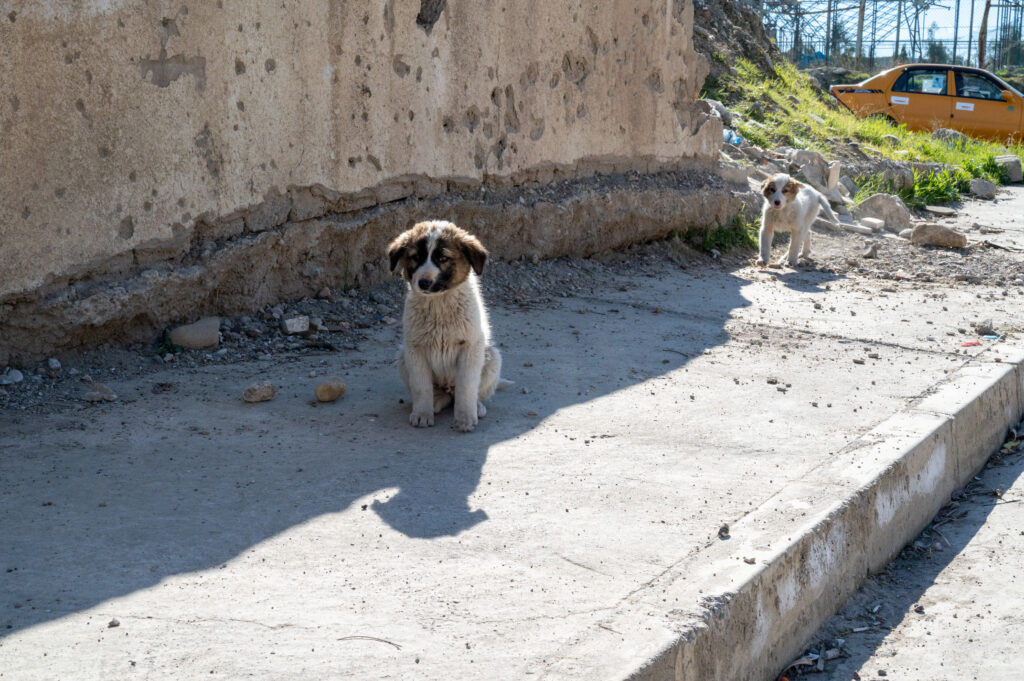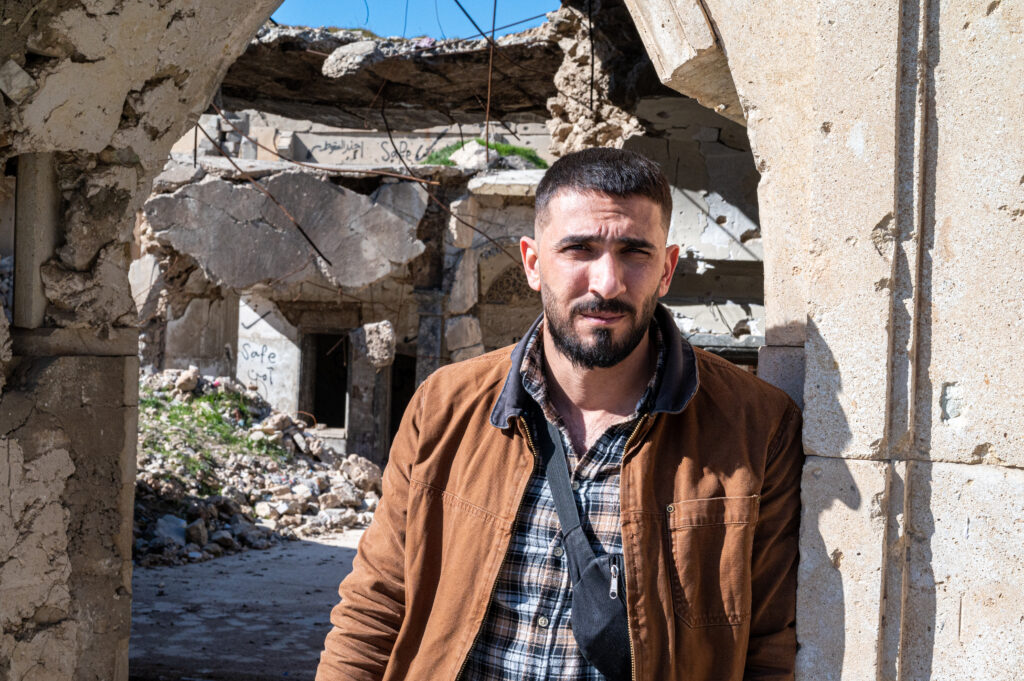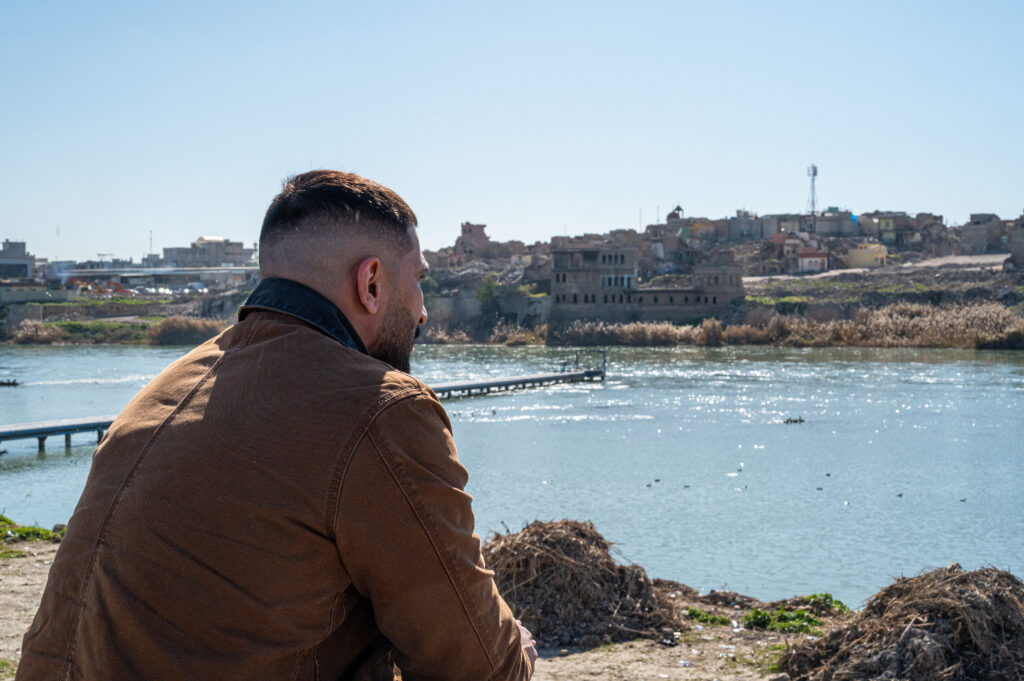Over the coming weeks, in a five-chapter series, we will share an inside story of Mosul, Iraq’s second biggest city. It will be told through the eyes of former Cordaid employee Othman Khalil, who grew up in the city during the Iraq War and survived occupation by ISIS. In love with his maimed city, he began humanitarian work right after the liberation battle. And he hasn’t stopped since.
“I was born in Mosul, on August 27 1995, in a hospital near the bookshop we are sitting in right now. It was during the war with Iran, Saddam ruled the country and international sanctions crippled our economy.
Both my parents were government employees, but their combined income wasn’t enough to feed me properly. We mostly ate rice, so I was very skinny as a baby and as a child. I made up, later, with bodybuilding.
Even though we were poor I have fond childhood memories. The city was clean, and life was clear. People knew where they were heading, and what turns to take. I went to school, did what boys do, and grew up with my brother and sisters. Life felt safe.

Back in those days, you could approach and even cuddle a cat or dog in the street. That’s impossible today, they have all gone wild and are terrified of people.
Rock, paper, scissors
Things changed after 2005. By then, the US invasion of Iraq which had started in 2003, had reached Mosul. I remember seeing the Americans for the first time. Their equipment, the night vision kits. The green lasers. They were mostly near banks and other important buildings, not in the smaller streets. When you saw them, you knew you couldn’t run. Any sudden movement could get you into trouble. So we just froze.
Once, this American soldier started talking to us. He wanted to play rock-paper-scissors with me and my mother tried to translate what he said. She probably got it wrong but she said that if I’d lose, he would cut my finger. She really believed that and so did I. I refused to play. It was my first interaction with a US soldier. The memory still scares me today.
Then came the raids, the clashes. They came in waves. I remember my mom and I were walking to the bakery. It was next to the governorate building. The streets were empty, and things felt weird. Suddenly, these desert sand-coloured Humvees appear. The moment US troops spotted us, they loaded their guns. This time, my mother said we had to hide and we ran into small alleys and hid. And then I heard, for the first time, bullets spinning through the air near us. A sharp whistling sound.
“It was my first interaction with a US soldier. The memory still scares me today.”
From then onwards, all memories I have of the Americans have to do with either bombs or armed clashes. I saw the raids, the helmets, the green lasers going in all directions. Even inside our own house. We were petrified. I was a young kid.
A common enemy
In Mosul, Sunnis are the majority but there are many ethnic-religious groups. Back then, we all lived together and supported each other, Sunni families, Shia, Kurds, and Yazidis. There were no real boundaries. In fact, among my really close friends, at the time, there were two boys, one Shia and one Yazidi. All parts of society supported each other, in schools, during events.
This feeling of unity and solidarity only grew stronger when the Americans came. We had a common enemy because their bombs hurt all of us.

Of course, there was armed resistance. When Mosul is attacked, as it has been for centuries, we fight back. I was too young to fight. Besides, I had different dreams, of becoming a doctor or an engineer. But the armed resistance was there and it would only grow.
In 2006, things took a bad turn. On television, people had seen the pictures taken in Abu Ghraib prison, of American soldiers torturing Iraqi prisoners of war. We saw the ugly faces of those who fought us. After this, men started joining the armed resistance in bigger numbers. Later, we found out that people around me, including older friends, had joined as well.
Underground resistance groups have always existed in Mosul. Under Saddam’s dictatorship and before that time. But now, all of a sudden they started finding the kind of community support they never had before. There was no talk of Al Qaida or ISIS yet, they were only known as ‘resistance’. Suicide attacks against US and coalition targets, ambushes, the use of improvised explosive devices… All that took a crazy flight.
Weird pressure
Then, little by little these resistance fighters started claiming they represented true Islam. The fighters had become Islamic fighters. There were the Sunni fighters that would later be called Al Qaida, with a lot of foreigners and with a focus on Syria, and those that would become ISIS mostly Iraqis that had their eyes on Iraq. But they collaborated, this was before they took separate ways. And there was the Shia resistance, which eventually became the umbrella of militias known as the Popular Mobilisation Forces, now part of the formal power structures.
By now I was twelve. There was a weird pressure on boys my age to join the armed Islamic resistance. They don’t just come and say ‘Hi Othman, you’re a good boy, come and join us’. No, first they come and invite you to play football. Then, they ask you to attend a club in the mosque. There, they start feeding you with ideas of who is bad and who is good. They use religion as a game to drug your mind. Later, recruitment tactics became rougher. They would hand out DVDs in schools, showing video clips of attacks and killings. And after the Sunni fighters, by then known as ISIS, had taken the city in 2014, their tactics of persuasion would become pure evil, as we would find out.
“We were divided. It was heart breaking.”
I don’t know why, but I didn’t yield to the pressure, in the mosque, on the football pitch, at school. Maybe because I was still too young. My parents were neutral. They thought both parties were bad, the armed fighters and the US who had invaded us.
Everyone was confused, trying to make sense of what was going on. No one knew what was really happening or how things would evolve. The worst was when we started not knowing who was good and who was bad anymore. Suspicion and fear crept into all of us. My parents were now forbidding me to meet and hang out with my three close friends. We were divided. It was heartbreaking.

Masterminds of violence
Saddam was Sunni, and ISIS claimed to be Sunni. So whenever US troops encountered problems, they targeted and profiled the Sunni population. This only fanned support for the Islamic fighters. It had a spiralling effect, which was exactly what the masterminds of violence, the US as well as the jihadist extremists, wanted. More and more innocent young men were arrested in raids and taken to US prisons. Here, they were brutally confronted with other inmates and with the extremism of Salafist ideology.
“Imprisonment was a form of recruitment. The US military knew this. In fact, they facilitated it.”
Someone I knew, who had spent time inside, once told me that if you try to stay neutral in prison you get harassed and beaten continuously. If you yield and join the extremists, they promise you protection and a lot of advantages for family members. Imprisonment was a form of recruitment. The US military knew this. In fact, they facilitated it. Because they thrived on instability. It allowed them to tighten their grip on the Middle East.
By 2007, every couple of months, there were big waves of targeted killings. By the resistance, the Islamic fighters, the US and others. Any public figure, anyone from the government who could possibly become too popular or influential was killed. This continued, to a lesser degree, until the day ISIS conquered the city in June 2014. Even my dad, a simple government official, received threats. Luckily he wasn’t a big shot.
Enemies of each other
So by now, the resistance, just like the US, is showing its true, ugly face. The feeling of solidarity we all felt in 2005, of having a common enemy, is completely gone. Instead, we were being divided and we found ourselves being enemies of each other, Sunni, Shia, Kurdish, Christians, and Yazidis.
By then, family life, life in general even, was governed by one rule: stay inside, don’t go out. I continued going to school in those years, but only because there was a school very near to our house.
Between 2010 and 2013 there was a short period of relative stability. Saddam was dead, US troops had retreated, international attention had shifted from Iraq to the war in Syria, and ISIS had not yet started its military offensive to capture our city. Prime Minister Al Maliki headed the government. Later, he would be the one to order the army to withdraw from the city, allowing ISIS to take over. But before that, for a while, he did a good job. The world was recovering from a global financial crisis and Iraq’s oil trade and income fared well. We could feel this in Mosul. It felt as if we could breathe a little bit.
Caught in crossfire
But my city had changed completely. Before the age of ten, I had never seen a checkpoint in my life. Now, at age 16, there were checkpoints everywhere. Military watchtowers were checking our every step. I was hardly allowed to go out, my parents were too afraid. They did everything to keep all of us alive. We had lost a relative, a cousin who was deaf. He hadn’t heard the warnings and was caught in the crossfire. When I was a kid, he used to make toy ships for me, made from pieces of wood.
“We had lost a relative, a cousin who was deaf. He hadn’t heard the warnings and was caught in crossfire.”
So far, in my own immediate family, we had all survived. But life as we knew it was gone. And the worst was only to come.”
Stay tuned
Next week we will publish part two of Mosul’s inside story, where Othman speaks of life under ISIS occupation. Find it on our website or via our LinkedIn account.
